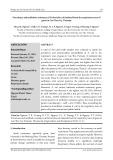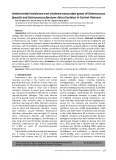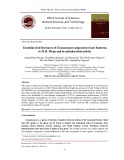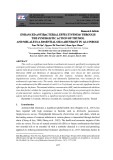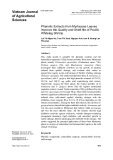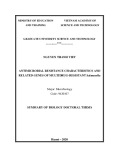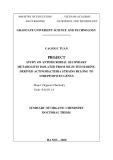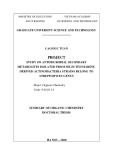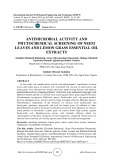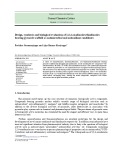Physical properties and surface activity of surfactant-like membranes containing the cationic and hydrophobic peptide KL4 Alejandra Sa´ enz1,*, Olga Can˜ adas1,*, Luı´s A. Bagatolli2, Mark E. Johnson3 and Cristina Casals1
1 Department of Biochemistry and Molecular Biology I, Complutense University of Madrid, Spain 2 MEMPHYS-Center for Biomembrane Physics, Department of Biochemistry and Molecular Biology, University of Southern Denmark,
Odense, Denmark
3 Discovery Laboratories, Mountain View, CA, USA
Keywords differential scanning calorimetry; DPH fluorescence; GUV; lung surfactant; surface adsorption
Correspondence C. Casals, Department of Biochemistry and Molecular Biology I, Faculty of Biology, Complutense University of Madrid, 28040 Madrid, Spain Fax: +34 91 3944672 Tel: +34 91 3944261 E-mail: ccasalsc@bio.ucm.es
*These authors contributed equally to this study
(Received 5 March 2006, revised 31 March 2006, accepted 3 April 2006)
doi:10.1111/j.1742-4658.2006.05258.x
interconverted to a b-sheet
Abbreviations Bodipy-PC, 2-(4,4-difluoro-5,7-dimethyl-4-bora-3a,4a-diaza-s-indacene-3-pentanoyl)-1-hexadecanoyl-sn-glycero-3-phosphocholine; DPH, 1,6-diphenyl-1,3,5-hexatriene; DPPC, 1,2-dipalmitoyl-phosphatidylcholine; DSC, differential scanning calorimetry; GUV, giant unilamellar vesicle; PA, palmitic acid; PC, phosphatidylcholine; POPC, 1-palmitoyl-2-oleoyl-phosphatidylcholine; POPG, 1-palmitoyl-2-oleoyl-phosphatidylglycerol; RDS, respiratory distress syndrome; SP-B, surfactant protein B; SP-C, surfactant protein C; Tm, gel to fluid phase transition temperature.
FEBS Journal 273 (2006) 2515–2527 ª 2006 The Authors Journal compilation ª 2006 FEBS
2515
Surfactant-like membranes containing the 21-residue peptide KLLLL- KLLLLKLLLLKLLLLK (KL4), have been clinically tested as a therapeu- tic agent for respiratory distress syndrome in premature infants. The aims of this study were to investigate the interactions between the KL4 peptide and lipid bilayers, and the role of both the lipid composition and KL4 structure on the surface adsorption activity of KL4-containing membranes. We used bilayers of three-component systems [1,2-dipalmitoyl-phosphat- idylcholine ⁄ 1-palmitoyl-2-oleoyl-phosphatidylglycerol ⁄ palmitic acid (DPPC ⁄ POPG ⁄ PA) and DPPC ⁄ 1-palmitoyl-2-oleoyl-phosphatidylcholine (POPC) ⁄ PA] and binary lipid mixtures of DPPC ⁄ POPG and DPPC ⁄ PA to examine the specific interaction of KL4 with POPG and PA. We found that, at low peptide concentrations, KL4 adopted a predominantly a-helical secondary structure in POPG- or POPC-containing membranes, and a b-sheet struc- ture in DPPC ⁄ PA vesicles. As the concentration of the peptide increased, structure in DPPC ⁄ POPG ⁄ PA or KL4 DPPC ⁄ POPC ⁄ PA vesicles. Ca2+ favored a«b interconversion. This con- formational flexibility of KL4 did not influence the surface adsorption activity of KL4-containing vesicles. KL4 showed a concentration-dependent ordering effect on POPG- and POPC-containing membranes, which could be linked to its surface activity. In addition, we found that the physical state of the membrane had a critical role in the surface adsorption process. Our results indicate that the most rapid surface adsorption takes place with vesicles showing well-defined solid ⁄ fluid phase co-existence at temperatures to fluid phase transition temperature, such as those below their gel of DPPC ⁄ POPG ⁄ PA and DPPC ⁄ POPC ⁄ PA. In contrast, more fluid (DPPC ⁄ POPG) or excessively rigid (DPPC ⁄ PA) KL4-containing mem- branes fail in their ability to adsorb rapidly onto and spread at the air– water interface.
A. Sa´ enz et al.
KL4 effects on surfactant-like liposomes
The human lung has an alveolar surface of 50–100 m2, which is completely covered with a lipid–protein com- plex called pulmonary surfactant [1]. The primary role of this material is to prevent collapse of the alveoli during end-expiration, preclude blood fluid transuda- tion into the alveolar spaces, participate in lung def- ense against inhaled pathogens and toxins, and modulate the function of respiratory inflammatory cells [1–4]. The alteration or deficiency of this system leads to respiratory distress.
(PC), is phosphatidylcholine performed with diluted KL4
little the
(KLLLLKLLLLKLLLLKLLLLK, where ‘K’ and ‘L’ represent the amino acids lysine and leucine, respect- ively), named KL4, to mimic the positive charge and hydrophobic residue distribution of SP-B. A synthetic lung surfactant formulation was developed based upon KL4 (Surfaxin(cid:1); lucinactant), which is composed of DPPC, 1-palmitoyl-2-oleoyl-phosphatidylglycerol (POPG), palmitic acid (PA) and KL4 at weight ratios of 28 : 9.3 : 5.0 : 1.0 and has been found to be very effective in the clinical trials of human RDS [11,12]. This KL4 concentration corresponds to 0.57 mol% and 2.3 wt%. Of great interest is the fact that airway surfactant lavage improves the lung function in experimental and clinical meconium aspiration syndrome [13] and in patients with acute respiratory distress syndrome (ARDS) [14]. The surface activity of KL4 peptide incorporated in bilayers and monolayers is well recognized [10,15–18]. However, interactions is known about between KL4 peptide and lipid bilayers, and their dependence on calcium. Therefore, the objectives of this study were to analyze (a) the effect of KL4 on the physical properties of membranes, in the absence and presence of Ca2+, using fluorescence anisotropy of 1,6-diphenyl-1,3,5-hexatriene (DPH), differential scan- ning calorimetry (DSC) and fluorescence confocal microscopy of giant unilamellar vesicles (GUVs), (b) the effect of the lipid composition on KL4 struc- ture, in the absence and presence of Ca2+, using CD and (c) the role of the lipid composition and peptide structure on surface adsorption activity. The main phospholipid constituent of pulmonary surfactant especially 1,2-dipalmitoyl-phosphatidylcholine (DPPC) [5]. Phos- phatidylglycerol represents a major unsaturated anionic component [5]. Four surfactant proteins (A, B, C and D) have been isolated. Surfactant protein B (SP-B) is a small hydrophobic protein that is essential for lung function and pulmonary homeostasis after birth. The genetic absence of SP-B in both humans and mice results in a lack of alveolar expansion and a lethal lack of pulmonary function [3]. In contrast, the genetic absence of surfactant protein C (SP-C), another small hydrophobic peptide, results in the normal expansion of alveoli and pulmonary function, although it is asso- ciated with interstitial lung diseases over time [3]. These hydrophobic proteins enhance the spreading, adsorp- tion and stability of surfactant lipids required for the reduction of surface tension in the alveolus [3]. On the other hand, surfactant protein A (SP-A) and surfactant protein D (SP-D) are oligomeric water-soluble proteins that modulate pulmonary innate immunity [4].
Results and Discussion
FEBS Journal 273 (2006) 2515–2527 ª 2006 The Authors Journal compilation ª 2006 FEBS
2516
Neonatal respiratory distress syndrome (RDS) is caused by lung immaturity with a deficiency of surfac- tant in the alveolar spaces. RDS is a major cause of morbidity and mortality in preterm babies. Experience from replacement therapy on RDS indicates that SP-B and SP-C are essential constituents of exogenous surf- actants [6]. Given that natural surfactants from animal sources raise microbiological, immunological, econo- mic and purity concerns, many efforts have been made to develop synthetic surfactant replacement formula- tions, which involve a combination of synthetic lipids with either synthetic or recombinant peptides [7]. Syn- thetic surfactant peptides, based on patterns of struc- ture or charge found in human SP-B or SP-C, appear to mimic some of the structural and functional proper- ties of the native proteins and thus may offer a useful basis for the design of agents for therapeutic interven- tion [7]. Studies of different fragments and mutants of SP-B suggest that the function-related structural and compositional characteristics of SP-B are its positive charges with intermittent hydrophobic domains [8,9]. Cochrane & Revak [10] designed a 21-residue peptide This study was performed with four different types of vesicles: DPPC ⁄ POPG (27 : 9, w ⁄ w), DPPC ⁄ POPG ⁄ PA (28 : 9.4 : 5.1, w ⁄ w ⁄ w), DPPC ⁄ 1-palmitoyl- 2-oleoyl-phosphatidylcholine (POPC) ⁄ PA (28 : 9.4 : 5.1, w ⁄ w ⁄ w), and DPPC ⁄ PA (28 : 5.1, w ⁄ w) with and with- out different amounts of the cationic and hydrophobic peptide, KL4. The composition of bilayers of three- component systems was chosen according to the fol- lowing criteria (a) a high DPPC content, which is the main phospholipid constituent of pulmonary surfac- tant, (b) the presence of unsaturated phospholipids (either POPG or POPC, which constitute up to 10% in human pulmonary surfac- and 20%, respectively, tant) [5] and (c) the presence of PA, which is a com- mon additive in replacement surfactants because it increases the surface activity of these formulations [18,19], except that of a synthetic surfactant based on a poly Leu SP-C analog [20]. In addition, binary lipid mixtures (DPPC ⁄ POPG and DPPC ⁄ PA) were used to
A. Sa´ enz et al.
KL4 effects on surfactant-like liposomes
specifically examine the interaction of KL4 with POPG and PA as well as the effect of these lipids on the physical properties of the membrane. in DPPC ⁄ POPG (black circles), DPPC ⁄ POPG ⁄ PA (black squares), and DPPC ⁄ POPC ⁄ PA (white squares) vesicles resulted in a small, but significant, increase in anisotropy.
Effect of KL4 on the lipid order of surfactant-like membranes
To establish whether the increase in DPH steady- state anisotropy in these vesicles caused by KL4 was the result of a greater molecular order of lipids sur- rounding DPH and a consequent slowing in DPH rota- tional diffusion, or of changes in DPH fluorescence lifetime, and, hence, changes in DPH steady-state fluor- escence intensity [22], we determined the effect of differ- ent amounts of KL4 on the fluorescence emission spectra of DPH in DPPC ⁄ POPG, DPPC ⁄ POPG ⁄ PA and DPPC ⁄ POPC ⁄ PA vesicles upon excitation at 340 nm, at 37 (cid:2)C. The lack of changes, within experi- mental error, in the fluorescence emission of DPH with increasing amounts of peptide (data not shown), allows us to infer that KL4 enhances the lipid order of DPPC ⁄ POPG, DPPC ⁄ POPG ⁄ PA and DPPC ⁄ POPC ⁄ PA membranes. These results are consistent with the ordering effect of SP-B and related peptides on the polar surface of DPPC ⁄ PG vesicles [23,24].
Thermotropic properties of KL4-containing membranes
To evaluate KL4 effects on the lipid order of surfac- tant-like liposomes, the steady-state fluorescence emis- sion anisotropy, r, of DPH incorporated in DPPC ⁄ POPG, DPPC ⁄ POPG ⁄ PA, DPPC ⁄ POPC ⁄ PA and DPPC ⁄ PA vesicles was measured as a function of KL4 concentration at 37 (cid:2)C (Fig. 1). In the absence of the peptide, DPH anisotropy values in DPPC ⁄ POPG vesi- cles were strikingly smaller than those obtained in membranes of either DPPC ⁄ POPC ⁄ PA or DPPC ⁄ POPG ⁄ PA. These results might be indicative of greater acyl chain order in PA-containing vesicles, allowing slower DPH rotational diffusion and hence higher DPH anisotropy values. For DPPC ⁄ PA at 37 (cid:2)C, the steady-state anisotropy of DPH in the absence of KL4 was (cid:1) 0.35, which is within the range of the observable DPH anisotropy in phospholipid vesicles in the gel phase (0.30–0.35) [21]. The incorporation of increasing KL4 concentrations in DPPC ⁄ PA liposomes resulted in insignificant changes in DPH anisotropy (Fig. 1, white circles). In contrast, increasing the KL4 concentration
Fig. 1. Steady-state emission anisotropy of 1,6-diphenyl-1,3,5-hex- atriene (DPH) incorporated in DPPC ⁄ POPG (d), DPPC ⁄ POPG ⁄ PA (n), DPPC ⁄ POPC ⁄ PA (h) or DPPC ⁄ PA (s) vesicles containing differ- ent concentrations of KL4 at 37 (cid:2)C. [Excitation wavelength (kx) ¼ 360 nm; emission wavelength (km) ¼ 430 nm.] Values represent the mean ± SD of three experiments. DPPC, 1,2-dipalmitoyl-phos- phatidylcholine; PA, palmitic acid; POPC, 1-palmitoyl-2-oleoyl-phos- phatidylcholine; POPG, 1-palmitoyl-2-oleoyl-phosphatidylglycerol.
Next, we used the nonperturbing technique of DSC to study the effect of KL4 on the thermotropic properties of surfactant-like membranes (Fig. 2). In the absence of the peptide, DPPC ⁄ POPG ⁄ PA, DPPC ⁄ POPC ⁄ PA and DPPC ⁄ PA multilamellar vesicles showed endotherms with a gel to fluid phase transition temperature (Tm) of 48.5, 46.1 and 52.2 (cid:2)C, respectively. In the absence of PA, the Tm of DPPC ⁄ POPG, DPPC ⁄ POPC and DPPC multilamellar vesicles shifted to lower temperatures (32.5, 35.3 and 41.5 (cid:2)C, respectively), indicating that the fatty acid markedly raised the main transition tem- perature of these types of vesicles. This is consistent with the PA ordering effect in DPPC ⁄ POPG ⁄ PA vesi- cles determined from DPH anisotropy measurements.
FEBS Journal 273 (2006) 2515–2527 ª 2006 The Authors Journal compilation ª 2006 FEBS
2517
DSC measurements indicated that a relatively small amount of KL4 (0.28 mol%) exerted a significant effect thermotropic behavior of DPPC ⁄ POPG, on the DPPC ⁄ POPG ⁄ PA and DPPC ⁄ POPC ⁄ PA vesicles. KL4 shifted the Tm of those vesicles somewhat upward (from 32.5 to 34 (cid:2)C for DPPC ⁄ POPG, from 48.5 to 49.0 (cid:2)C for DPPC ⁄ POPG ⁄ PA, and from 46.1 to 48.3 (cid:2)C for DPPC ⁄ POPC ⁄ PA) and narrowed the phase increase in Tm is in transition (Fig. 2). The slight agreement with the KL4 ordering effect determined from DPH anisotropy measurements. The KL4- induced narrowing of the phase transition might be a consequence of the interaction of KL4 with POPG
A. Sa´ enz et al.
KL4 effects on surfactant-like liposomes
Fig. 2. Differential scanning calorimetry (DSC) heating scans of DPPC ⁄ POPG, DPPC ⁄ POPG ⁄ PA, DPPC ⁄ POPC ⁄ PA and DPPC ⁄ PA multilamel- lar vesicles (1 mM) in the absence and presence of different concentrations of KL4. The mole percentage of KL4 is indicated on each thermo- gram. The dashed line represents the thermogram of DPPC ⁄ POPC multilamellar vesicles (1 mM). Calorimetric scans were performed at a rate of 0.5 (cid:2)CÆmin)1. DPPC, 1,2-dipalmitoyl-phosphatidylcholine; PA, palmitic acid; POPC, 1-palmitoyl-2-oleoyl-phosphatidylcholine; POPG, 1-palmitoyl-2-oleoyl-phosphatidylglycerol.
and ⁄ or PA [15], which may decrease the miscibility between these lipids and DPPC. A high level of misci- bility between DPPC and POPG in bilayers or mono- layers has been reported [15,25] and can be visualized for GUVs of DPPC ⁄ POPG and DPPC ⁄ POPC shown in this study.
from 46.1
In addition, DSC thermograms indicated that, at peptide mole percentages higher than 0.28, the ther- mal transition of POPG-containing vesicles was char- acterized by a double peak. This double peak was not observed in DPPC ⁄ POPC ⁄ PA or DPPC ⁄ PA vesi- cles, indicating that it must be generated by electro- static interactions between the positively charged lysine residues of KL4 and the anionic headgroup of (0.57– POPG. On the other hand, when KL4 1.8 mol%) was incorporated into DPPC ⁄ PA vesicles, the main transition temperature did not change. However, KL4 induced narrowing of the phase trans- ition, which is a measure of stabilization of DPPC- rich assemblies.
Effect of calcium on the thermotropic properties of KL4-containing membranes
FEBS Journal 273 (2006) 2515–2527 ª 2006 The Authors Journal compilation ª 2006 FEBS
2518
In order to simplify the nature of the thermal trans- ition of these vesicles and allow a less ambiguous assessment of the effect of KL4, calcium was omitted in the DSC experiments reported above. However, cal- cium ions affect the structure and biophysical activity of lung surfactant [1,2]. Moreover, calcium is present in the alveolar fluid at a concentration of (cid:1) 1.8 mm [26]. To determine whether the presence of calcium modifies the effects of KL4 on the thermotropic behav- ior of surfactant-like vesicles, experiments in the pres- ence of physiological concentrations of calcium were performed. Figure 3 shows that the addition of 1.8 mm CaCl2 to DPPC ⁄ POPG vesicles, containing 0.57 mol% KL4, slightly increased the phase transition tempera- the presence of calcium ture (Fig. 3A). However, markedly decreased the main transition temperature of PA-containing membranes with 0.57 mol% KL4. Thus, in the presence of Ca2+, the Tm values of KL4-con- taining membranes shifted from 52.2 to 49.5 (cid:2)C for to 41.5 (cid:2)C for DPPC ⁄ PA (Fig. 3B), DPPC ⁄ POPC ⁄ PA (Fig. 3C), and from 48.5 to 39.5 (cid:2)C for DPPC ⁄ POPG ⁄ PA (Fig. 3D). These results suggest that the calcium-dependent Tm decrease observed only in PA-containing membranes might be caused by spe- cific interactions between the fatty acid and calcium ions, which seem to result in the partial extraction of PA from the bilayer. Further addition of calcium, up to 5 mm, did not appreciably modify the thermotropic properties of DPPC ⁄ POPG ⁄ PA, DPPC ⁄ POPC ⁄ PA and DPPC ⁄ PA membranes containing 0.57 mol% KL4
A. Sa´ enz et al.
KL4 effects on surfactant-like liposomes
indicates that at
at 25 (cid:2)C, a temperature below its Tm [28], and this phenomenon was independent of the presence of sur- factant proteins [28]. The fact that the end of the melt- ing process occurs at 41 (cid:2)C, this temperature (for instant, under high-fever conditions) surfactant membranes would be in the fluid state. The Tm of KL4-DPPC ⁄ POPG ⁄ PA (39.5 ± 0.1 (cid:2)C) was quite similar to the Tm of human lung surfactant in the presence of calcium and showed the end of the melting process at 41–42 (cid:2)C. This suggests the fitness of this synthetic surfactant based on KL4.
(B) DPPC ⁄ PA,
(A) DPPC ⁄ POPG,
Fig. 3. Effect of calcium on the differential scanning calorimetry (DSC) heating scans of (C) DPPC ⁄ POPC ⁄ PA and (D) DPPC ⁄ POPG ⁄ PA vesicles containing 0.57 mol% KL4, and of (E) human lung surfactant isolated from healthy subjects. Calorimetric scans were performed at a rate of 0.5 (cid:2)CÆmin)1 in the absence (broken line) or presence (unbroken line) of 1.8 mM CaCl2. DPPC, 1,2-dipalmitoyl-phosphatidylcholine; PA, pal- mitic acid; POPC, 1-palmitoyl-2-oleoyl-phosphatidylcholine; POPG, 1- palmitoyl-2-oleoyl-phosphatidylglycerol.
Effect of calcium and ⁄ or KL4 on lipid lateral organization of surfactant-like membranes
of GUVs prepared
(data not shown). This calcium-dependent Tm decrease was independent of the presence of KL4 in the vesicles, as it was also observed in PA-containing vesicles with- out KL4 (data not shown). These results are consistent with those of Henshaw and co-workers [27], who sug- gested that the calcium-dependent attenuation of PA- induced alterations of bilayer properties probably involved the extraction of PA from the bilayer at con- centrations of > 100 lm calcium. Thus, the formation of PA–Ca2+ complexes might explain the decrease of the Tm of PA-containing vesicles induced by Ca2+.
process above 41 (cid:2)C and
FEBS Journal 273 (2006) 2515–2527 ª 2006 The Authors Journal compilation ª 2006 FEBS
2519
Figure 3 also shows calcium effects on the thermo- tropic properties of human lung surfactant isolated from healthy subjects (Fig. 3E). The thermogram obtained from human lung surfactant was character- ized by a thermal transition showing the end of the a Tm of melting 37.2 ± 0.1 (cid:2)C in the presence of calcium, which shif- ted slightly downward (36.2 ± 0.1 (cid:2)C) in its absence. These data suggest that gel and fluid phases may co- exist at physiological temperatures in surfactant mem- branes from human lungs. Lateral phase separation in natural surfactant from pig lungs was recently shown To gain insight into the effects of calcium and ⁄ or KL4 on the lipid lateral organization of surfactant-like membranes, confocal fluorescence microscopy of GUVs was employed. GUVs were prepared from DPPC ⁄ POPG, DPPC ⁄ POPC, DPPC ⁄ POPG ⁄ PA and DPPC ⁄ POPC ⁄ PA multilamellar vesicles doped with the fluorescent probe 2-(4,4-difluoro-5,7-dimethyl-4-bora- 3a,4a-diaza-s-indacene-3-pentanoyl)-1-hexadecanoyl-sn- glycero-3-phosphocholine (Bodipy-PC) (Fig. 4). These ‘cell size’ vesicles (the average diameter was 21–25 lm) permit the direct visualization of lipid domain forma- tion. POPG and ⁄ or PA-containing vesicles showed co- existing bright and dark domains at room temperature, well below their Tm. As Bodipy-PC partitions in the fluid phase [29], dark regions can be ascribed to DPPC- rich solid domains. Figure 4 shows that the number of DPPC solid domains is very low in DPPC ⁄ POPG GUVs in the absence of calcium, indicating a high level of miscibility between DPPC and POPG in these bilayers. Comparison from DPPC ⁄ POPG and DPPC ⁄ POPG ⁄ PA in the absence of Ca2+ indicated that adding PA to binary lipid mixtures of DPPC ⁄ POPG led to a considerable increase in the number and size of solid domains. These results are consistent with DPH anisotropy and DSC measure- ments reported above (Figs 1 and 2, respectively). Fur- thermore, Fig. 4 shows that the addition of Ca2+ to GUVs of DPPC ⁄ POPG increased the number of the addition of Ca2+ to solid domains, while DPPC ⁄ POPG ⁄ PA vesicles led to a marked decrease of the DPPC-rich solid domain fraction. These results are consistent with the calcium-dependent decrease of Tm by 10 (cid:2)C determined by DSC measurements (Fig. 3) and can be explained by the partial extraction of PA from the membrane. The different lipid lateral organ- ization in DPPC ⁄ POPG and DPPC ⁄ POPG ⁄ PA in the presence of Ca2+ strongly suggests that PA must not be totally extracted from the bilayer. Figure 4 also
A. Sa´ enz et al.
KL4 effects on surfactant-like liposomes
Fig. 4. Ca2+ effects on the lipid lateral orga- nization of giant unilamellar vesicles (GUVs) prepared from DPPC ⁄ POPG and DPPC ⁄ POPG ⁄ PA (upper panel), and DPPC ⁄ POPC and DPPC ⁄ POPC ⁄ PA (lower panel) multila- mellar vesicles doped with the fluorescent probe, 2-(4,4-difluoro-5,7-dimethyl-4-bora- 3a,4a-diaza-s-indacene-3-pentanoyl)-1-hexa- decanoyl-sn-glycero-3-phosphocholine (Bodipy-PC). Images were taken at 25 (cid:2)C. The scale bars correspond to 5 lm. DPPC, 1,2-dipalmitoyl-phosphatidylcholine; PA, palmitic acid; POPC, 1-palmitoyl-2-oleoyl- phosphatidylcholine; POPG, 1-palmitoyl-2- oleoyl-phosphatidylglycerol.
shows that DPPC ⁄ POPC ⁄ PA, but not DPPC ⁄ POPC, giant vesicles showed the co-existence of gel ⁄ fluid phases at room temperature, and that the addition of Ca2+ resulted in a visible decrease of the solid domain fraction.
Fig. 5. KL4 (0.57 mol%) effects on the lipid lateral organization of giant unilamellar vesi- cles (GUVs) prepared from DPPC ⁄ POPG ⁄ PA (upper panel) and DPPC ⁄ POPC ⁄ PA (lower panel) lipids in the absence and presence of Ca2+. Images were taken at 25 (cid:2)C. All the GUVs in the figure were labeled with the lipophilic fluorescence probe, 2-(4,4-difluoro- 5,7-dimethyl-4-bora-3a,4a-diaza-s-indacene-3- pentanoyl)-1-hexadecanoyl-sn-glycero-3-pho- sphocholine (Bodipy-PC). The scale bars correspond to 5 lm. Fluorescence images of vesicle aggregation induced by KL4 are also shown. DPPC, 1,2-dipalmitoyl-phosphat- idylcholine; PA, palmitic acid; POPC, 1-palmitoyl-2-oleoyl-phosphatidylcholine; POPG, 1-palmitoyl-2-oleoyl-phosphatidyl- glycerol.
FEBS Journal 273 (2006) 2515–2527 ª 2006 The Authors Journal compilation ª 2006 FEBS
2520
Figure 5 shows KL4 effects on the lipid lateral organization of GUVs prepared from surfactant-like lipids in the absence and presence of Ca2+. The yield of individual GUVs was very low in the presence of KL4, and the GUVs formed displayed a smaller diam- eter (the average diameter was 11 lm) than in the absence of the peptide. Aggregates of vesicles could be visualized, indicating that the peptide induced vesicle aggregation. Figure 5 shows that the incorporation of KL4 in either DPPC ⁄ POPG ⁄ PA or DPPC ⁄ POPC ⁄ PA giant vesicles induced changes in the shape and size of the solid domains. It is likely that the electrostatic interaction of KL4 with POPG and ⁄ or PA would decrease the electrostatic repulsion between charged li- pids and the miscibility between these lipids and DPPC, stabilizing DPPC-rich assemblies. The addition of calcium to DPPC ⁄ POPG ⁄ PA or DPPC ⁄ POPC ⁄ PA
A. Sa´ enz et al.
KL4 effects on surfactant-like liposomes
samples containing KL4 reduced the DPPC-rich solid domain fraction, which is consistent with the calcium- dependent consequent extraction of PA and the decrease of Tm (Fig. 3). Importantly, these DPPC ⁄ POPG ⁄ PA or DPPC ⁄ POPC ⁄ PA vesicles containing KL4 showed the co-existence of solid ⁄ fluid phases at room temperature, well below their Tm.
Effect of the lipid composition on KL4 secondary structure and its dependence of calcium
Fig. 6. CD spectra of KL4 incorporated in DPPC ⁄ POPG, DPPC ⁄ POPG ⁄ PA, DPPC ⁄ POPC ⁄ PA and DPPC ⁄ PA membranes in the absence and presence of 1.8 mM CaCl2. The following mol percentage concentrations of KL4 were used: 0.57 (unbroken line), 1.2 (broken line) and 1.8 (dotted line). DPPC, 1,2-dipalmitoyl-phosphatidylcholine; PA, palmitic acid; POPC, 1-palmitoyl-2-oleoyl-phosphatidylcholine; POPG, 1-palmitoyl- 2-oleoyl-phosphatidylglycerol.
FEBS Journal 273 (2006) 2515–2527 ª 2006 The Authors Journal compilation ª 2006 FEBS
2521
monolayers lies in the nonaqueous region and that the strong electrostatic forces between lysine residues and the anionic headgroup of phosphatidylglycerol dictate that the lysines would anchor along the charged polar headgroups, whereas the leucine side chains would penetrate the hydrophobic regions. The peptide would adopt a conformation with its backbone parallel to the interface. It would be possible for the peptide to dis- play a random coil that might even take on some char- acteristics of a beta sheet or alpha helix. Fig. 6 shows that at low KL4 concentrations (0.57 mol%), typically used in surfactant replacement for the clinical treat- ment of human RDS, KL4 exhibited CD features con- sistent with an a-helical conformation in all vesicles that contained bilayer-fluidizing unsaturated phospho- lipids (i.e. POPG or POPC). These CD spectra were The studies on KL4 peptide available to date are not conclusive with regard to the secondary structure of the peptide in phospholipid membranes typically used in synthetic lung surfactant replacement. Cochrane & Revak [10] suggested that KL4 in DPPC ⁄ PG mixed
A. Sa´ enz et al.
KL4 effects on surfactant-like liposomes
that calcium could partly inhibit this interaction as a result of the partial extraction of PA from the mem- brane.
ratio) monolayers characterized by two ellipticity minima at 208 and 222 nm and a marked maximum at 195 nm, as shown in Fig. 6. In contrast, KL4 adopted a predominantly b-sheet structure, characterized by an ellipticity mini- mum at 220 nm and a maximum at 198 nm, in the ves- icles lacking a membrane-fluidizing unsaturated lipid, specifically DPPC ⁄ PA. This indicates that the secon- dary structure of in surfactant-like the peptide membranes strongly depends on the presence of unsat- urated phospholipids (either POPG or POPC) and therefore on membrane fluidity.
at is, KL4
We have also studied calcium effects on the secon- dary structure of KL4 inserted in these vesicles. Fig- ure 6 (lower panel) shows that the addition of 1.8 mm Ca2+ did not substantially alter the KL4 secondary low concentrations structure. That (0.57 mol%) retained its a-helical structure in the pres- ence of calcium in the POPG or POPC-containing vesi- cles. In DPPC ⁄ PA vesicles; however, KL4 adopted a predominantly b-sheet structure.
Our results agree with those of Cai et al. [16] and Gustafsson et al. [17], who studied the secondary struc- ture of relatively high concentrations of KL4 incorpor- ated in monolayers or bilayers in the absence of Ca2+. Cai and co-workers showed that 2.5–5 mol% KL4 adopted an antiparallel b-sheet structure in DPPC and DPPC ⁄ DPPG (7 : 3, mol [16], whereas Gustafsson et al. found that 2.5 mol% KL4 adopted an a-helix in DPPC ⁄ unsaturated-PG (7 : 3, w ⁄ w) bilayers [17]. In summary, our results supplemen- ted by those published previously [16,17] permit the conclusion that the a-helical structure of KL4 incor- porated in membranes requires both neutralization of the positive charges of KL4 with the negative charge of membrane lipids and the presence of unsaturated phospholipids, which decrease bilayer packing density. KL4 a«b transition takes place in membranes exhibit- ing solid ⁄ fluid phase co-existence, such as those of DPPC ⁄ POPG ⁄ PA or DPPC ⁄ POPC ⁄ PA, as the concen- tration of the peptide increased. This is favored by the presence of Ca2+, which caused surface charge neutral- ization and ⁄ or PA extraction.
Role of the lipid composition and peptide structure on surface adsorption activity
Fig. 7. Effect of different concentrations of KL4 on the interfacial adsorption kinetics of DPPC ⁄ POPG, DPPC ⁄ POPG ⁄ PA, DPPC ⁄ POPC ⁄ PA and DPPC ⁄ PA membranes in the presence of calcium. Phospholipid interfacial adsorption was measured as a function of time for samples containing 70 lgÆmL)1 of phospholipids in the absence (s) and presence of 0.28 mol% (d), 0.57 mol% (d), 1.2 mol% (d), 1.8 mol% (m), and 2.1 mol% (n) KL4 in a final volume of 6 mL of 5 mM Hepes buffer, pH 7.0, containing 150 mM NaCl and 1.8 mM CaCl2. Similar results were found in the presence of 5 mM CaCl2. DPPC, 1,2-dipalmitoyl-phosphatidylcholine; PA, palmitic acid; POPC, 1-palmitoyl-2-oleoyl-phos- phatidylcholine; POPG, 1-palmitoyl-2-oleoyl-phosphatidylglycerol.
FEBS Journal 273 (2006) 2515–2527 ª 2006 The Authors Journal compilation ª 2006 FEBS
2522
interactions between the Figure 7 shows the ability of different surfactant-like vesicles (DPPC ⁄ POPG, DPPC ⁄ POPG ⁄ PA, DPPC ⁄ POPC ⁄ PA and DPPC ⁄ PA) with and without different amounts of KL4 to adsorb onto and spread at an air– water interface in the presence of physiological Ca2+ On the other hand, we found that a-helix to b-sheet in DPPC ⁄ POPG ⁄ PA and transition takes place in DPPC ⁄ DPPC ⁄ POPC ⁄ PA membranes, but not POPG membranes, as a consequence of the pep- tide ⁄ lipid concentration increase. This transition was more apparent in the presence of Ca2+, especially in DPPC ⁄ POPC ⁄ PA vesicles (Fig. 6). The a-helical struc- ture of KL4 in these vesicles seems to be favored by electrostatic interactions between the positively charged lysine residues and negatively charged lipids (POPG and ⁄ or PA). Considering that the a-helical structure of KL4 in DPPC ⁄ POPC ⁄ PA vesicles might be favored by electrostatic charged is conceivable lysine residues and ionized PA, it
A. Sa´ enz et al.
KL4 effects on surfactant-like liposomes
required for appropriate
air–water interface. These results indicated that the presence of PA in surfactant-like membranes was deci- sive for rapid surface adsorption induced by KL4 and that the replacement of the anionic POPG by the zwit- terionic phospholipid POPC did not affect the surface activity of KL4-surfactant. The common denominator of DPPC ⁄ POPG ⁄ PA and DPPC ⁄ POPC ⁄ PA vesicles, with and without KL4, was that these membranes exhibited similar lipid lateral organization with co-exist- ing fluid and solid phases, both in the absence and pres- ence of calcium (Figs 4 and 5).
concentrations. Adsorption is carried out through (a) the transport of the material injected through the bulk liquid to the air ⁄ liquid interface and (b) the spreading of the material along the surface, which involved con- version from bilayer aggregates to interfacial film [30]. An inefficient surfactant adsorption would lead to a slower increase in surface pressure and the need for greater compression to attain the nearly zero surface lung function. tensions Synthetic replacement surfactants must adsorb quickly to a clean interface in a concentration-dependent man- ner up to the equilibrium surface pressure, pe (40– 45 mNÆm)1) [7].
On the other hand, our results indicated that the conformational flexibility of the peptide (a-helical to b-sheet) did not affect the surface adsorption activity of KL4-containing liposomes. These results suggest that the presence of a-helices is not critical for the sur- face activity of KL4 peptide. They also corroborate previous findings of Castano and co-workers [31], who indicated that a predominantly a-helical structure is not essential for the surface activity of proteins or pep- tides containing alternating charged and hydrophobic residues.
Fig. 8. Effect of KL4 on the interfacial adsorption kinetics of DPPC ⁄ POPG, DPPC ⁄ POPG ⁄ PA, DPPC ⁄ POPC ⁄ PA, and DPPC ⁄ PA membranes in the absence of CaCl2. Phospholipid interfacial adsorption was measured as a function of time for samples containing 70 lgÆmL)1 (circles) or 160 lgÆmL)1 of phospholipid (triangles) in the absence (white symbols) and presence (black symbols) of 0.57 mol% KL4 in a final volume of 6 mL of 5 mM Hepes buffer, pH 7.0, containing 150 mM NaCl. DPPC, 1,2-dipalmitoyl-phosphatidylcholine; PA, palmitic acid; POPC, 1-palmitoyl-2-oleoyl-phosphatidylcholine; POPG, 1-palmitoyl-2-oleoyl-phosphatidylglycerol.
FEBS Journal 273 (2006) 2515–2527 ª 2006 The Authors Journal compilation ª 2006 FEBS
2523
Figure 7 shows that, in the absence of the peptide, the vesicles (final phospholipid concentration of 70 lgÆmL)1) showed no or very slow adsorption rates and neither system attained the equilibrium pressure, pe, even with prolonged adsorption times. The presence of KL4 improved the adsorption rate of all these lipo- somes, which increased with increasing mol% KL4. Results also indicate that lipid composition plays a crit- ical role in the surface activity of KL4-surfactant prepa- rations. Both KL4-DPPC ⁄ POPG and KL4-DPPC ⁄ PA surfactants showed slow adsorption rates and did not achieve the equilibrium pressure, even in the presence for KL4-DPPC ⁄ of high mol% KL4. In contrast, POPG ⁄ PA and KL4-DPPC ⁄ POPC ⁄ PA surfactants con- taining KL4 concentrations of ‡ 0.57 mol%, the surface pressure rose exponentially up to pe. Concentrations of KL4 higher than 1.2 mol% had no further effect on sur- face adsorption rate. Therefore, KL4-DPPC ⁄ POPG ⁄ PA and KL4-DPPC ⁄ POPC ⁄ PA surfactants were markedly superior to KL4-DPPC ⁄ POPG surfactant (more fluid) and KL4-DPPC ⁄ PA surfactant (excessively rigid) in their ability to adsorb rapidly onto and spread at an The mechanism by which KL4 peptide, or the sur- factant proteins SP-B and SP-C, promote the rapid adsorption of surfactant-like vesicles to an air ⁄ water interface is not understood. The fusion of vesicle aggregates to the air ⁄ water interface must imply bilayer disruption. Energy must be supplied first to overcome hydration repulsion between membranes that approach each other and, second, to disrupt the normal bilayer structure of the fusing membranes. We show here that KL4 induces vesicle aggregation (Fig. 5). This might facilitate the build-up of a multilayered surface-associ- ated surfactant reservoir. In addition, KL4 might act synergistically with Ca2+ to cause charge neutralization
A. Sa´ enz et al.
KL4 effects on surfactant-like liposomes
indicate
The presence of PA in either DPPC ⁄ POPG or DPPC ⁄ POPC membranes containing KL4 was import- ant as PA leads to the lateral redistribution of lipids, increasing the fraction of DPPC-rich solid domains, which results in phase separation. Several studies indi- cate that phase separation exists in natural surfactant [28] and in membranes from lipid extracts of surfactant [34] at physiological temperatures. Together, these find- ings suggest that phase co-existence in synthetic surfac- tants at physiological temperatures might be important for them to function adequately.
and local dehydration of contacting surfaces containing POPG ⁄ PA- or POPC ⁄ PA-rich domains. Adsorption experiments performed in the absence of calcium that KL4-containing DPPC ⁄ (Fig. 8) (final POPG ⁄ PA or DPPC ⁄ POPC ⁄ PA membranes phospholipid concentration of 70 lgÆmL)1) showed very slow adsorption rates and did not reach the equi- librium surface pressure. It was necessary to raise the amount of lipid in samples containing 0.57 mol% KL4 to 160 lgÆmL)1 to achieve pe (Fig. 8). These results indicate that KL4 and Ca2+ seem to act synergistically in the surface adsorption process. We speculate that in the presence of KL4 and ⁄ or Ca2+, the unsaturated phospholipids, POPC and POPG, might form transient, negatively curved structures in the bilayer–monolayer transition [32,33] or rapidly flip to the air–water inter- face.
Conclusions
One disadvantage of surfactant-like mixtures contain- ing PA is that the Tm of these vesicles is very high. However, we found that calcium markedly decreased the Tm of PA-containing vesicles. Thus, in the presence of physiological concentrations of calcium, the Tm value of KL4-containing DPPC ⁄ POPG ⁄ PA membranes shifted from 48.3 to 39.5 (cid:2)C. This Tm value was quite similar to that of human lung surfactant membranes isolated from healthy subjects (37.2 (cid:2)C), and both sys- tems showed the end of the melting process at 41 (cid:2)C. The decrease of the Tm in PA-containing vesicles is explained by the partial extraction of PA from the bilay- er by the formation of PA ⁄ Ca2+ complexes. The differ- ent Tm and lipid lateral organization in DPPC ⁄ POPG and DPPC ⁄ POPG ⁄ PA vesicles in the presence of Ca2+ clearly indicated that PA was just partly extracted from the bilayer. These results suggest that the amount of PA needed to increase the fraction of DPPC-rich solid domains and improve the in vitro surface activity of synthetic surfactants is much smaller than that previ- ously proposed [19]. Hence, the results reported here might be useful for designing new lipid mixtures for replacement surfactants containing synthetic or recom- binant peptides with optimal surface activity.
Experimental procedures
Materials
Synthetic lipids, DPPC, POPG, POPC, and PA were pur- chased from Avanti Polar Lipids (Birmingham, AL, USA). The organic solvents (methanol and chloroform) used to dissolve the lipids were HPLC-grade (Scharlau, Barcelona, Spain). Bodipy-PC and DPH were purchased from Molecu- lar Probes (Eugene, OR, USA). All other reagents were of analytical grade and obtained from Merck (Darmstadt, Germany).
Vesicles of DPPC ⁄ POPG (27 : 9, w ⁄ w), DPPC ⁄ POPG ⁄ PA (28 : 9.4 : 5.1, w ⁄ w ⁄ w), DPPC ⁄ POPC ⁄ PA (28 : 9.4 : 5.1, w ⁄ w ⁄ w) and DPPC ⁄ PA (28 : 5.1, w ⁄ w), with different amounts of KL4 peptide, were prepared as previously repor- ted [35,36]. The sample solutions were prepared by mixed
In summary, we report that both the membrane lipid composition and the presence of calcium affected the KL4 structure. The secondary structures adopted by the peptide are a function of (a) the negative charge on the membrane surface, which in turn depends on the presence of calcium, (b) the bilayer packing density, and (c) the concentration of the peptide in the mem- brane. We found that KL4 adopted a predominantly a-helical secondary structure in DPPC ⁄ POPG vesicles and a predominantly b-sheet structure in DPPC ⁄ PA vesicles, independently of the presence of calcium and at different peptide mole percentages (0.57–1.8 mol%). However, in DPPC ⁄ POPG ⁄ PA or DPPC ⁄ POPC ⁄ PA liposomes, KL4 interconverted to a b-sheet structure as the concentration of the peptide increased. This process was favored in the presence of Ca2+. KL4 a«b con- formational flexibility did not influence the surface adsorption activity of KL4-containing vesicles. We sug- gest that the KL4 concentration-dependent ordering effect on POPG and POPC-containing membranes and the peptide’s ability to induce vesicle aggregation are related to its surface activity.
FEBS Journal 273 (2006) 2515–2527 ª 2006 The Authors Journal compilation ª 2006 FEBS
2524
With respect to the lipid component of KL4-contain- ing synthetic surfactants, we found that the physical state of the membrane plays a critical role in the surface adsorption process. Thus, KL4-containing DPPC ⁄ POPG ⁄ PA and DPPC ⁄ POPC ⁄ PA vesicles, which showed well-defined solid ⁄ fluid phase co-existence at temperatures below their Tm, exhibited very rapid surface adsorption, even in the absence of calcium. In contrast, more fluid (DPPC ⁄ POPG) or excessively rigid (DPPC ⁄ PA) KL4-containing membranes fail in their ability to rapidly adsorb onto an air–water interface.
A. Sa´ enz et al.
KL4 effects on surfactant-like liposomes
stock solution of the lipid and the peptide, both prepared in chloroform ⁄ methanol, to achieve the desired lipid ⁄ peptide ratio. Human lung surfactant was isolated and characterized as described previously [37].
with Bodipy-PC, as reported previously [28], was spread on the surface of each platinum wire as small drops. The chamber was then placed under a stream of N2 and subse- quently under low vacuum for 30 min to allow the native material to adsorb onto the platinum wire. An important point in this step is to avoid dehydration of the sample to maintain the integrity of the membranes. Once the material was adsorbed to the platinum wire, aqueous solution was added to the chamber (200 mosM sucrose solution pre- pared with Millipore-filtered water, 17.5 megohmsÆcm)1). The sucrose solution was previously heated to the desired temperature (above the lipid mixture phase transition), and then sufficient volume was added to cover the platinum ((cid:1) 300 lL). The platinum wires were connected wires immediately to a function generator (Digimess(cid:1) FG 100, Vann Draper electronics Ltd., Derby, UK), and a low-fre- quency AC field (sinusoidal wave function with a frequency of 10 Hz and an amplitude of 3 V) was applied for 60 min. After vesicle formation, the AC field was turned off, and the vesicles were collected with a pipette and transferred to a plastic tube.
Steady-state fluorescence emission anisotropy measurements were carried out using an SLM-Aminco AB2 spectrofluo- rimeter equipped with Glam prism polarizers and a thermo- stated cuvette holder (Thermo Spectronic, Waltham, MA, USA) (± 0.1 (cid:2)C), using 5 · 5 mm path-length quartz cuvettes. The required amounts of KL4 surfactant were mixed with DPH at a probe ⁄ phospholipid molar ratio of 1 : 200 (final phospholipid concentration of 1 mgÆmL)1), as previously described [35]. Excitation and emission wave- lengths were set at 360 and 430 nm, respectively. For each sample, fluorescence emission intensity data in parallel and perpendicular orientations, with respect to the exciting beam, were collected 10 times each and then averaged. Background intensities in DPH-free samples as a result of the vesicles were subtracted from each recording of fluores- cence intensity. Anisotropy, r, was calculated as:
Emission anisotropy measurements
r ¼
Ik (cid:2) G (cid:3) I? Ik þ 2G (cid:3) I?
where Ii and I^ are the parallel and perpendicular polarized intensities measured with the vertically polarized excitation light and G is the monochromator grating correction factor.
Observation of giant vesicles
sample
cell of
Aliquots of giant vesicles suspended in sucrose were added to an equi-osmolar concentration of glucose solution. Because of the density difference between the two solu- tions, the vesicles precipitate at the bottom of the cham- ber, which facilitates observation of the GUVs in the inverted confocal microscope. GUV preparations were (Laboratory-Tek observed in 12-well plastic chambers Brand Products, Naperville, IL, USA). The chamber was located in an inverted confocal microscope (Zeiss LSM 510 META, Zeiss, Jena, Germany) for observation. The excitation wavelength was 488 nm for Bodipy-PC. The temperature was controlled from a water bath connected to a homemade device into which the 12-well plastic chamber was inserted. The temperature was measured inside the sample chamber using a digital thermocouple (model 400B; Omega Inc., Stamford, CT, USA) with a precision of 0.1 (cid:2)C. Unilamellarity was assured by measur- ing the fluorescence intensity of the equator region, as pre- viously described [39].
DSC
Calorimetric measurements were performed as previously reported [35] in a Microcal VP DSC (Microcal Inc., Nor- thampton, MA, USA) at a heating rate of 0.5 (cid:2)CÆmin)1. Surfactant-like multilamellar vesicles (1 mm), in the absence and presence of different amounts of KL4, were loaded in the the microcalorimeter with buffer (130 mm NaCl, 20 mm Tris ⁄ HCl, pH 7.6, either with or without 1.8 mm CaCl2) in the reference cell. Three calori- metric scans were collected from each sample between 15 and 70 (cid:2)C. For each preparation, the analysis was repeated two or three times. The standard microcal origin soft- ware was used for data acquisition and analysis. The excess heat capacity functions were obtained after subtraction of the buffer–buffer baseline.
CD measurements
CD spectra of surfactant-like vesicles (final phospholipid concentration of 800 lgÆmL)1) containing different amounts of KL4 were obtained on a Jasco J-715 spectropolarimeter fitted with a 150-watt xenon lamp as previously performed with surfactant proteins SP-A, SP-B, and SP-C [36,40,41]. Quartz cells of 1 mm path-length were used. Four scans were accumulated and averaged for each spectrum. The acquired spectra were corrected by subtracting the appro- priate blank runs of phospholipid vesicle solutions, subjec-
GUVs composed of DPPC ⁄ POPG, DPPC ⁄ POPC, DPPC ⁄ POPG ⁄ PA, or DPPC ⁄ POPC ⁄ PA, in the absence and pres- ence of KL4, were prepared from lipid samples suspended in buffer solution (no organic solvents), as described previ- ously [28], by using the electroformation method [38]. Briefly, (cid:1) 3 lL of the stock suspension in buffer, labelled
FEBS Journal 273 (2006) 2515–2527 ª 2006 The Authors Journal compilation ª 2006 FEBS
2525
GUV
A. Sa´ enz et al.
KL4 effects on surfactant-like liposomes
6 Robertson B & Halliday HL (1998) Principles of surfac- tant replacement. Biochim Biophys Acta 1408, 346–361.
7 Robertson B, Johansson J & Curstedt T (2000) Syn- thetic surfactants to treat neonatal lung disease. Mol Med Today 6, 119–124.
ted to noise reduction analysis, and presented as molar el- lipticities (degÆcm2Ædmol)1). All measurements were per- formed in 130 mm NaCl, 20 mm Tris ⁄ HCl buffer, pH 7.6, at 25 (cid:2)C, in the absence or presence of either 1.8 mm or 5 mm CaCl2. For each preparation, the analysis was repea- ted at least three times. Estimation of the secondary struc- ture content from the CD spectra was performed after deconvolution of the spectra into four simple components (a-helix, b-sheet, b-turns, and random coil), according to the convex constraint algorithm [42].
8 Revak SD, Merritt TA, Degryse E, Stefani L, Courtney M, Hallman M & Cochrane CG (1988) Use of human surfactant low molecular weight apoproteins in the reconstitution of surfactant biologic activity. J Clin Invest 81, 826–833.
9 Waring A, Taeusch W, Bruni R, Amirkhanian J, Fan B, Stevens R & Young J (1989) Synthetic amphipathic sequences of surfactant protein-B mimic several physico- chemical and in vivo properties of native pulmonary sur- factant proteins. Pept Res 2, 308–313.
10 Cochrane CG & Revak SD (1991) Pulmonary surfac-
tant protein B (SP-B): structure–function relationships. Science 254, 566–568.
11 Cochrane CG, Revak SD, Merritt TA, Heldt GP, Hall-
man M, Cunningham MD, Easa D, Pramanik A, Edwards DK & Alberts MS (1996) The efficacy and safety of KL4-surfactant in preterm infants with respira- tory distress syndrome. Am J Respir Crit Care Med 153, 404–410.
The ability of the lipid mixtures to absorb onto and spread at the air–water interface was tested in the absence and presence of KL4, at 25 and 37 (cid:2)C, in a Wilhelmy-like high sensitive surface microbalance [36,43]. The samples were injected into the hypophase chamber of the Teflon dish, which contained 6 mL of 5 mm Hepes buffer, pH 7.0, 150 mm NaCl, either with or without 5 mm CaCl2, with continuous stirring. Interfacial adsorption was measured following the change in surface tension as a function of time. For each preparation, the analysis was repeated at least three times.
12 Sinha SK, Lacaze-Masmonteil T, Valls i Soler A,
Adsorption assays
Acknowledgements
Wiswell TE, Gadzinowski J, Hajdu J, Bernstein G, San- chez-Luna M, Segal R, Schaber CJ et al. (2005) Surfax- in Therapy Against Respiratory Distress Syndrome Collaborative Group. A multicenter, randomized, con- trolled trial of lucinactant versus poractant alfa among very premature infants at high risk for respiratory dis- tress syndrome. Pediatrics 115, 1030–1038.
13 Cochrane CG, Revak SD, Merritt TA, Schraufstatter
IU, Hoch RC, Henderson C, Andersson S, Takamori H & Oades ZG (1998) Bronchoalveolar lavage with KL4- surfactant in models of meconium aspiration syndrome. Pediatr Res 44, 705–715.
14 Wiswell TE, Smith RM, Katz LB, Mastroianni L,
This work was supported by Fondo de Investigacio´ n Sanitaria 03 ⁄ 0137 and by Dr Esteve, S.A. Laboratorios (Barcelona). Research in the laboratory of L. A. B. is funded by a grant from SNF, Denmark (21-03-0569) and the Danish National Research Foundation (which supports MEMPHYS-Center for Biomembrane Phys- ics). We acknowledge Dr Charles Cochrane, from the Scripps Research Institute (La Jolla, CA 92037), for his useful suggestions on a critical reading of the manuscript.
References
Wong DY, Willms D, Heard S, Wilson M, Hite RD, Anzueto A et al. (1999) Bronchopulmonary segmental lavage with surfaxin (KL4-surfactant) for acute respirat- ory distress syndrome. Am J Respir Crit Care Med 160, 1188–1195.
1 Goerke J (1998) Pulmonary surfactant: functions and molecular composition. Biochim Biophys Acta 1408, 79–89.
2 Piknova B, Schram V & Hall S (2002) Pulmonary sur-
factant: phase behaviour and function. Curr Opin Struct Biol 21, 487–494.
15 Ma J, Koppenol S, Yu H & Zografi G (1998) Effects of a cationic and hydrophobic peptide, KL4, on model lung surfactant lipid monolayers. Biophys J 74, 1899– 1907.
3 Whitsett JA & Weaver TE (2002) Hydrophobic surfac-
tant proteins in lung function and disease. N Engl J Med 347, 2141–2148.
4 Wright JR (2005) Immunomodulatory functions of sur-
factant proteins. Nat Rev Immunol 5, 58–68.
16 Cai P, Flach CR & Mendelsohn R (2003) An infrared reflection-absorption spectroscopy study of the second- ary structure in KL4, a therapeutic agent for respiratory distress syndrome, in aqueous monolayers with phos- pholipids. Biochemistry 42, 9446–9452.
17 Gustafsson M, Vandenbussche G, Curstedt T, Ruyss-
5 Veldhuizen EJ, Nag K, Orgeig S & Possmayer F (1998) The role of lipids in pulmonary surfactant. Biochim Bio- phys Acta 1408, 90–108.
chaert JM & Johansson J (1996) The 21-residue surfac- tant peptide (LysLeu)4Lys (KL4) is a transmembrane
FEBS Journal 273 (2006) 2515–2527 ª 2006 The Authors Journal compilation ª 2006 FEBS
2526
A. Sa´ enz et al.
KL4 effects on surfactant-like liposomes
a-helix with a mixed nonpolar ⁄ polar surface. FEBS Lett 384, 185–188.
30 Walters RW, Jenq RR & Hall SB (2000) Distinct steps in the adsorption of pulmonary surfactant to an air– liquid interface. Biophys J 78, 257–266.
31 Castano S, Desbat B, Laguerre M & Dufourcq J (1999) Structure, orientation and affinity for interfaces and lipids of ideally amphipathic lytic LiKj (i¼2j) peptides. Biochim Biophys Acta 1416, 176–194.
18 Nilsson G, Gustafsson M, Vandenbussche G, Veldhui- zen E, Griffiths WJ, Sjo¨ vall J, Haagsman HP, Ruyss- chaert JM, Robertson B, Curstedt T et al. (1998) Synthetic peptide-containing surfactants. Evaluation of transmembrane versus amphipathic helices and surfac- tant protein C poly-valyl and poly-leucyl substitution. Eur J Biochem 255, 116–124.
32 Schram V & Hall SB (2004) SP-B and SP-C alter diffu- sion in bilayers of pulmonary surfactant. Biophys J 86, 3734–3743.
19 Tanaka Y, Takei T, Aiba T, Masuda K, Kiuchi A & Fujiwara T (1986) Development of synthetic lung sur- factants. J Lipid Res 27, 475–485.
33 Biswas SC, Rananavare SB & Hall SB (2005) Effects of gramicidin-A on the adsorption of phospholipids to the air–water interface. Biochim Biophys Acta 1717, 41–49. 34 Nag K, Pao JS, Harbottle RR, Possmayer F, Petersen NO & Bagatolli LA (2002) Segregation of saturated chain lipids in pulmonary surfactant films and bilayers. Biophys J 82, 2041–2051.
20 Johansson J, Some M, Linderholm BM, Almlen A, Cur- stedt T & Robertson B (2003) A synthetic surfactant based on a poly-Leu SP-C analog and phospholipids: effects on tidal volumes and lung gas volumes in venti- lated immature newborn rabbits. J Appl Physiol 95, 2055–2063.
21 Lentz BR (1989) Membrane ‘fluidity’ as detected by
35 Canadas O, Guerrero R, Garcia-Canero R, Orellana G, Mene´ ndez M & Casals C (2004) Characterization of liposomal tacrolimus in lung surfactant-like phospholi- pids and evaluation of its immunosuppressive activity. Biochemistry 43, 9926–9938.
diphenylhexatrien probes. Chem Phys Lipids 50, 171–190. 22 Lakowicz JR (1999) Principles of Fluorescence Spectros- copy, 2nd edn. Kluwer Academic ⁄ Plenum Publishers, New York.
36 Sanchez-Barbero F, Strassner J, Garcia-Canero R,
23 Baatz JE, Sarin V, Absolom DR, Baxter C & Whitsett JA (1991) Effects of surfactant-associated protein SP-B synthetic analogs on the structure and surface activity of model membrane bilayers. Chem Phys Lipids 60, 163–178.
24 Vincent JS, Revak SD, Cochrane CG & Levin IW
Steinhilber W & Casals C (2005) Role of the degree of oligomerization in the structure and function of human surfactant protein A. J Biol Chem 280, 7659–7670. 37 Casals C, Arias-Diaz J, Valin˜ o F, Saenz A, Garcia C, Balibrea JA & Vara E (2003) Surfactant stregthens the inhibitory effect of C-reactive protein on human lung macrophage cytokine release. Am J Physiol Lung Cell Mol Physiol 284, L466–L472.
(1991) Raman spectroscopic studies of model human pulmonary surfactant systems: phospholipid interactions with peptide paradigms for the surfactant protein SP-B. Biochemistry 30, 8395–8401.
25 Piknova B, Schief WR, Vogel V, Discher BM & Hall
SB (2001) Discrepancy between phase behavior of lung surfactant phospholipids and the classical model of sur- factant function. Biophys J 81, 2172–2180.
38 Angelova MI & Dimitrov DS (1986) Liposome electro- formation. Faraday Discuss Chem Soc 81, 303–311. 39 Akashi K, Miyata H, Itoh H & Kinosita K Jr (1996) Preparation of giant liposomes in physiological condi- tions and their characterization under an optical micro- scope. Biophys J 71, 3242–3250.
26 Nielson DW (1986) Electrolite composition of pulmon- ary alveolar subphase in anesthetized rabbits. J Appl Physiol 60, 972–979.
40 Ruano MLF, Perez-Gil J & Casals C (1998) Effect of acidic pH on the structure and lipid binding properties of porcine surfactant protein A. Potential role of acidifi- cation along its exocytic pathway. J Biol Chem 273, 15183–15191.
27 Henshaw JB, Olsen CA, Farnbach AR, Nielson KH & Bell JD (1998) Definition of the specific roles of lysole- cithin and palmitic acid in altering the susceptibility of dipalmitoylphosphatidylcholine bilayers to phospholi- pase A2. Biochemistry 37, 10709–10721.
28 Bernardino de la Serna J, Perez-Gil J, Simonsen AC &
41 Cruz A, Casals C & Perez-Gil J (1995) Conformational flexibility of pulmonary surfactant proteins SP-B and SP-C, studied in aqueous organic solvents. Biochim Biophys Acta 1255, 68–76.
Bagatolli LA (2004) Cholesterol rules: direct observation of the coexistence of two fluid phases in native pulmon- ary surfactant membranes at physiological temperatures. J Biol Chem 279, 40715–40722.
42 Perczel A, Park K & Fasman GD (1992) Analysis of the circular dichroism spectrum of proteins using the convex constraint algorithm: a practical guide. Anal Biochem 203, 83–93.
29 Huang N, Florine-Casteel K, Feigenson GW & Spink C
(1988) Effect of fluorophore linkage position of n-(9-anthroyloxy) fatty acids on probe distribution between coexisting gel and fluid phospholipid phases. Biochim Biophys Acta 939, 124–130.
43 Casals C, Varela A, Ruano MLF, Valin˜ o F, Perez-Gil J, Torre N, Jorge E, Tendillo F & Castillo-Olivares JL (1998) Increase of C-reactive protein and decrease of surfactant protein A in surfactant alter lung transplan- tation. Am J Respir Crit Care Med 175, 43–49.
FEBS Journal 273 (2006) 2515–2527 ª 2006 The Authors Journal compilation ª 2006 FEBS
2527








